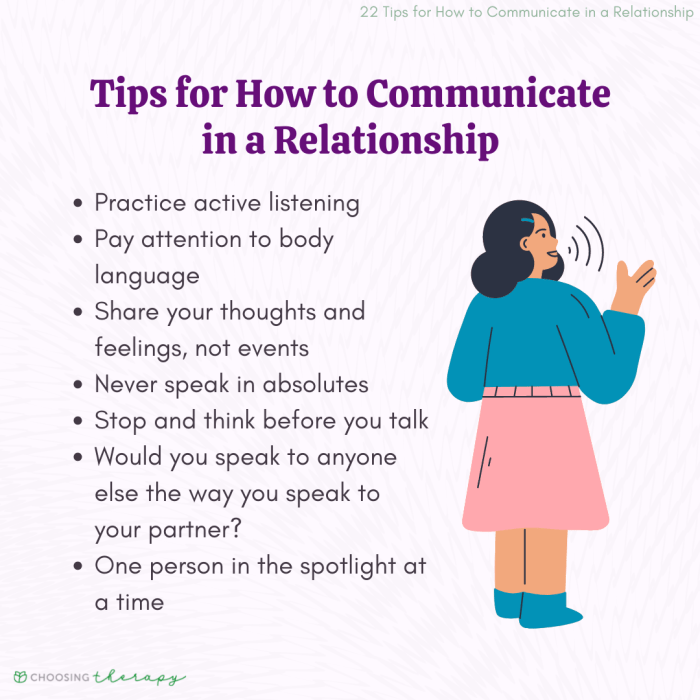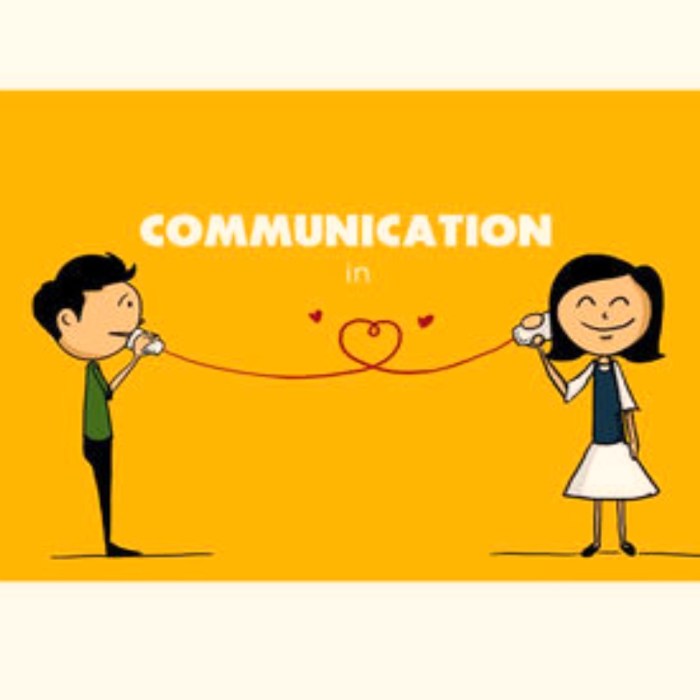Learning to Communicate in a Relationship: Building Stronger Bonds

Learning to communicate in a relationship sets the stage for this enthralling narrative, offering readers a glimpse into a story that is rich in detail and brimming with originality from the outset. Communication is the lifeblood of any relationship, whether it’s romantic, familial, or platonic.
It’s the bridge that connects us, allowing us to share our thoughts, feelings, and experiences. Effective communication is more than just talking; it’s about understanding, listening, and responding in a way that fosters connection and understanding.
This guide delves into the intricate world of communication in relationships, exploring various communication styles, active listening techniques, the importance of expressing needs and setting boundaries, and strategies for navigating conflicts constructively. It also examines the role of nonverbal communication, emotional intelligence, and the impact of technology on modern relationships.
By understanding these principles and applying them in our interactions, we can cultivate healthier, more fulfilling relationships.
Understanding Communication Styles

Effective communication is the cornerstone of any successful relationship. It’s not just about the words we use, but also about how we say them and how we interpret what others say. Recognizing different communication styles can significantly improve understanding and minimize misunderstandings.
Different Communication Styles
Understanding various communication styles is essential for navigating relationships effectively. Different styles influence how individuals express themselves, interpret information, and respond to others.
- Assertive Communication: Assertive communicators express their needs and opinions clearly and respectfully, while also considering the feelings and perspectives of others. They are direct and honest while maintaining a calm and confident demeanor. Assertive communication is generally considered the most effective and healthy style, fostering mutual respect and understanding.
- Passive Communication: Passive communicators often avoid expressing their needs and opinions directly, fearing conflict or rejection. They may agree with others even when they disagree, leading to resentment and bottled-up emotions. Passive communication can hinder personal growth and create an imbalance in the relationship.
- Aggressive Communication: Aggressive communicators prioritize their needs and opinions over others, often using forceful language, interrupting, and blaming. They may be verbally abusive, creating a hostile environment and damaging the relationship. Aggressive communication can lead to conflict, resentment, and emotional distance.
- Passive-Aggressive Communication: Passive-aggressive communicators express their dissatisfaction indirectly through sarcasm, subtle put-downs, or manipulative behaviors. They may withhold information or use guilt trips to get their way. Passive-aggressive communication can create confusion and tension, making it difficult to address underlying issues.
Influence of Communication Styles on Relationships
Communication styles significantly influence the dynamics of relationships. Misunderstandings often arise when individuals have contrasting styles, leading to misinterpretations and conflict.
“Communication is the key to any successful relationship.”
Unknown
For example, a person with an assertive communication style may find it challenging to understand a partner who is passive. The assertive individual may perceive their partner’s silence as disinterest or lack of respect, while the passive individual may feel overwhelmed and intimidated by their partner’s directness.
This difference in communication style can lead to frustration and resentment. Similarly, an aggressive communicator may come across as domineering and disrespectful to a partner who prefers a more passive approach. The aggressive individual may feel unheard or unappreciated, while the passive individual may feel pressured and controlled.
This imbalance can create an unhealthy power dynamic in the relationship. Understanding and acknowledging the different communication styles present in a relationship is crucial for building healthy and fulfilling connections.
Active Listening and Empathy: Learning To Communicate In A Relationship
Active listening and empathy are fundamental pillars of healthy communication in any relationship. They enable partners to understand each other’s perspectives, build trust, and foster a sense of connection.
Importance of Active Listening
Active listening goes beyond simply hearing words; it involves actively engaging with what your partner is saying, both verbally and nonverbally. It signifies that you are paying attention, valuing their thoughts and feelings, and creating a safe space for them to express themselves.
Active listening is crucial for:
- Building Trust and Understanding: When you actively listen, you demonstrate that you care about what your partner has to say, fostering trust and deepening understanding.
- Resolving Conflicts: Active listening allows you to understand the root cause of disagreements, fostering a collaborative approach to finding solutions.
- Strengthening Bonds: By paying attention to your partner’s thoughts and feelings, you show that you value their presence and contribute to a stronger emotional connection.
Techniques for Practicing Active Listening
Active listening is a skill that can be learned and honed over time. Here are some techniques to enhance your active listening abilities:
- Maintain Eye Contact: Eye contact demonstrates that you are engaged and attentive to your partner.
- Non-Verbal Cues: Nodding, leaning in, and using open body language show that you are actively listening and interested.
- Summarize and Clarify: Reflect on what your partner has said to ensure you understand their message accurately.
- Ask Open-Ended Questions: Encourage your partner to elaborate on their thoughts and feelings by asking open-ended questions.
- Avoid Interruptions: Allow your partner to express themselves fully without interrupting or changing the subject.
Demonstrating Empathy
Empathy is the ability to understand and share another person’s feelings. It involves stepping into their shoes and trying to see the world from their perspective. Demonstrating empathy in communication strengthens relationships by:
- Building Emotional Connection: Empathy shows that you care about your partner’s well-being and understand their emotional state.
- Reducing Conflict: Empathy can help you see things from your partner’s point of view, reducing misunderstandings and potential conflict.
- Promoting Trust: When you show empathy, you build trust by demonstrating that you understand and care about your partner’s feelings.
Scenario: Active Listening and Empathy in Conflict Resolution
Imagine a scenario where one partner, Sarah, is upset about a recent decision made by her partner, David, without consulting her. Sarah feels unheard and disrespected. David, on the other hand, feels he decided in their best interest. In this situation, active listening and empathy are crucial for resolving the conflict.
David needs to actively listen to Sarah’s feelings and understand why she feels hurt and disrespected. He needs to acknowledge her perspective, even if he doesn’t agree with it. Sarah, in turn, needs to be receptive to David’s explanation and try to understand his motivations. By actively listening to each other’s perspectives and demonstrating empathy, they can work towards a resolution that respects both their needs and feelings.
Expressing Needs and Boundaries
Clear communication is the cornerstone of a healthy relationship. It allows partners to understand each other’s perspectives, desires, and limits. Expressing needs and setting boundaries are crucial aspects of this communication process. Healthy boundaries are essential for maintaining a sense of self-worth and protecting your emotional and physical well-being.
They help define what you are comfortable with and what you are not.
Asserting Needs and Boundaries
Communicating your needs and boundaries is crucial for building a strong and respectful relationship. Assertive communication techniques can help you express yourself effectively without being aggressive or passive.
- “I” Statements: Use “I” statements to focus on your feelings and needs without blaming your partner. For example, instead of saying “You never listen to me,” try “I feel unheard when I share my thoughts.”
- Be Direct and Specific: Be clear about what you need or what you are not comfortable with. For example, instead of saying “I need more space,” try “I need some time alone after work to de-stress.”
- Use “I” Statements to Express Needs: “I need more time for myself,” “I need to feel respected in our relationship,” and “I need more help with household chores.”
- Use “I” Statements to Express Boundaries: “I am not comfortable with you talking to me like that,” “I need you to respect my personal space,” “I need you to communicate your needs to me directly instead of assuming things.”
- Be Assertive, Not Aggressive: Assertive communication is about expressing your needs and boundaries clearly and respectfully, without being aggressive or demanding.
- Be Prepared for Resistance: It is natural for people to resist change. If your partner is resistant to your needs or boundaries, stay calm and continue to communicate your needs assertively.
Common Relationship Needs and Communication Strategies
| Relationship Needs | Effective Communication Strategies |
|---|---|
| Quality Time | “I would love to spend some quality time with you this weekend. How about we go for a walk in the park?” |
| Affection | “I feel loved when you give me hugs and kisses.” |
| Support | “I need your support to get through this challenging time.” |
| Trust | “I need to feel that I can trust you completely.” |
| Respect | “I need you to respect my decisions, even if you don’t agree with them.” |
Conflict Resolution and Negotiation
Conflict is a natural part of any relationship, whether it’s romantic, familial, or professional. It arises from differing opinions, values, or needs. However, how you approach and resolve conflicts can significantly impact the health and longevity of your relationship. Learning effective conflict resolution and negotiation skills is crucial for fostering a healthy and fulfilling connection.
Approaches to Conflict Resolution
Different approaches to conflict resolution can be more effective depending on the situation and personalities involved. Here are some common approaches:
- Avoidance: This approach involves ignoring or withdrawing from the conflict, hoping it will resolve itself. While it can be a temporary solution, it can lead to resentment and unresolved issues.
- Accommodation: This approach involves giving in to the other person’s demands to avoid conflict. While it can help preserve harmony, it can also lead to feelings of resentment and unfairness.
- Competition: This approach involves trying to win the conflict at the expense of the other person. It can be effective in situations where a quick decision is needed, but it can also damage relationships.
- Compromise: This approach involves finding a solution that meets the needs of both parties, but may involve some sacrifices from both sides. It can be a fair and balanced approach, but it may not always be the most ideal solution.
- Collaboration: This approach involves working together to find a solution that addresses the needs of both parties. It requires open communication, empathy, and a willingness to find common ground. This approach is generally considered the most constructive and effective in the long run.
Effective Negotiation Strategies
Negotiation is an essential part of conflict resolution. It involves discussing the issues, finding common ground, and reaching an agreement that works for both parties. Here are some effective negotiation strategies:
- Active Listening: Pay close attention to what your partner is saying, both verbally and nonverbally. Try to understand their perspective and emotions.
- Empathy: Put yourself in your partner’s shoes and try to understand their point of view, even if you don’t agree with it.
- Focus on Interests, Not Positions: Instead of focusing on your demands, try to understand the underlying interests that drive your partner’s position. This can help you find creative solutions that meet both parties’ needs.
- Brainstorming: Work together to generate a range of possible solutions. This can help you find a solution that is mutually beneficial.
- Be Willing to Compromise: Negotiation often involves making concessions. Be willing to compromise on some issues to reach an agreement.
Navigating Conflicts Constructively, Learning to communicate in a relationship.
Here’s a step-by-step guide for constructively navigating conflicts:
- Choose the Right Time and Place: Avoid discussing sensitive issues when you’re tired, stressed, or distracted. Choose a time and place where you can both feel comfortable and focused.
- Start with a Calm and Respectful Tone: Begin by expressing your appreciation for your partner and acknowledging their perspective. This sets a positive tone for the conversation.
- Clearly State Your Needs and Feelings: Use “I” statements to express your needs and feelings without blaming or attacking your partner. For example, instead of saying “You always make me feel ignored,” say “I feel ignored when I don’t get your attention.”
- Listen Actively and Empathetically: Pay attention to what your partner is saying, both verbally and nonverbally. Try to understand their perspective and emotions.
- Work Together to Find Solutions: Brainstorm together to find solutions that meet both parties’ needs. Be willing to compromise and be flexible.
- Agree on a Plan of Action: Once you reach an agreement, make sure you both understand the plan of action and how you will move forward. This can help prevent future conflicts.
Nonverbal Communication
Nonverbal communication is an essential aspect of effective communication in relationships. It involves conveying messages through body language, tone of voice, and facial expressions, which often complement or contradict spoken words. Understanding and interpreting nonverbal cues is crucial for building strong connections and navigating interpersonal dynamics.
Body Language
Body language encompasses a wide range of physical gestures, postures, and movements that convey meaning. It can express emotions, attitudes, and intentions, often unconsciously. For instance, crossed arms may indicate defensiveness or closed-offness, while an open posture with relaxed shoulders suggests openness and receptiveness.
Eye contact plays a significant role in nonverbal communication, with sustained eye contact generally indicating attentiveness and interest, while avoiding eye contact may signal disinterest or discomfort.
Tone of Voice
The tone of voice, or how words are spoken, can dramatically alter the message conveyed. A gentle, soft tone can express warmth and affection, while a harsh, loud tone can convey anger or frustration. Similarly, a monotone voice may indicate boredom or disengagement, while a lively, animated tone can signal enthusiasm and excitement.
The pace, pitch, and volume of speech all contribute to the overall tone and impact of the message.
Facial Expressions
Facial expressions are powerful nonverbal cues that can instantly communicate a wide range of emotions. A smile, for example, conveys happiness and friendliness, while a frown indicates sadness or disapproval. Other common facial expressions include surprise, anger, fear, and disgust, each carrying a distinct meaning and influencing the interpretation of the message.
Examples of Nonverbal Communication in Relationships
Nonverbal cues play a vital role in shaping relationship dynamics. For instance, a warm embrace can express love and affection, while a cold shoulder can signal distance and resentment. A gentle touch can convey comfort and reassurance, while a forceful gesture can express anger or aggression.
Similarly, a raised eyebrow can express skepticism or disbelief, while a nod can indicate agreement or understanding.
Nonverbal communication is a powerful tool for building and maintaining healthy relationships. By paying attention to nonverbal cues, we can enhance our understanding of our partners’ emotions, intentions, and needs, fostering deeper connections and resolving conflicts more effectively.
Communication and Emotional Intelligence

Emotional intelligence plays a crucial role in effective communication, especially within relationships. It allows individuals to understand and manage their own emotions while also recognizing and responding to the emotions of others. This understanding and management of emotions can significantly improve communication by fostering empathy, building trust, and promoting healthy conflict resolution.
The Importance of Emotional Intelligence in Communication
Emotional intelligence is the ability to understand and manage emotions effectively. It involves self-awareness, self-regulation, empathy, and social skills. These skills are essential for effective communication because they enable individuals to:
- Understand their own emotions: By recognizing and understanding their feelings, individuals can communicate their needs and desires more clearly. This self-awareness helps prevent misunderstandings and promotes open communication.
- Manage their emotions: Effective communication requires the ability to regulate emotions, especially in challenging situations. Individuals with high emotional intelligence can express their feelings constructively without resorting to anger, defensiveness, or withdrawal.
- Empathize with others: Empathy allows individuals to understand and share the feelings of others. This skill is crucial for active listening and responding appropriately to the emotional needs of their partners.
- Build trust and rapport: By demonstrating emotional intelligence, individuals can foster trust and rapport with their partners. This creates a safe and supportive environment for open and honest communication.
Understanding and Managing Emotions in Relationships
Understanding and managing emotions is essential for healthy communication within a relationship. By recognizing and acknowledging their own emotions, individuals can express themselves more effectively. This also helps them understand and respond to the emotions of their partners. Here are some strategies for managing emotions in relationships:
- Identify triggers: Recognizing what triggers strong emotional responses can help individuals anticipate and manage their reactions in difficult conversations.
- Practice mindfulness: Paying attention to the present moment without judgment can help individuals become more aware of their emotions and how they impact their communication.
- Use “I” statements: Expressing feelings and needs using “I” statements can help individuals communicate assertively without blaming or accusing their partners.
- Take breaks: If emotions become overwhelming, it’s important to take a break from the conversation to calm down and regain composure.
Examples of Emotional Intelligence in Communication Scenarios
Here are some examples of how emotional intelligence can be applied to different communication scenarios in relationships:
- During a conflict: When a conflict arises, emotionally intelligent individuals can acknowledge their partner’s feelings, listen actively, and seek a solution that addresses both their needs and their partner’s needs. They avoid resorting to personal attacks or blaming.
- When expressing difficult emotions: When needing to express difficult emotions like anger or sadness, emotionally intelligent individuals can do so in a calm and respectful manner, using “I” statements to articulate their feelings and needs.
- During a celebration: When celebrating a happy occasion, emotionally intelligent individuals can express their joy and appreciation for their partner, fostering a sense of connection and intimacy.
Maintaining Open and Honest Communication
Open and honest communication is the cornerstone of any healthy and fulfilling relationship. It fosters trust, intimacy, and a deep understanding between partners. When communication is open and honest, it allows for vulnerability, empathy, and the ability to navigate challenges together.
The Importance of Open and Honest Communication
Open and honest communication is crucial for building a strong foundation of trust and intimacy in a relationship. When partners feel safe and comfortable sharing their thoughts, feelings, and experiences openly and honestly, it creates a sense of connection and mutual understanding.
This openness allows for vulnerability, which in turn fosters deeper intimacy and emotional connection.
Strategies for Fostering Open Communication
Creating a Safe Space for Vulnerability
- Active Listening: Practice active listening skills, focusing on understanding your partner’s perspective without judgment or interruption. This creates a safe space for them to share their thoughts and feelings freely.
- Empathy and Validation: Demonstrate empathy by acknowledging and validating your partner’s emotions, even if you don’t agree with them. This shows that you care about their feelings and are willing to understand their perspective.
- Non-Judgmental Communication: Avoid criticizing or judging your partner’s thoughts or feelings. Instead, focus on understanding their point of view and communicating your perspective respectfully.
- Open Body Language: Maintain open body language, such as relaxed posture, eye contact, and nodding, to show that you are engaged and receptive to what your partner is saying.
- Positive Reinforcement: Acknowledge and appreciate your partner’s efforts to communicate openly and honestly. This positive reinforcement encourages them to continue doing so.
Establishing Clear Communication Guidelines
- Regular Check-ins: Schedule regular check-ins, even if it’s just for a few minutes each day, to discuss your thoughts, feelings, and any issues that may be arising.
- “I” Statements: Use “I” statements to express your feelings and needs without blaming or accusing your partner. For example, instead of saying “You always make me feel bad,” try “I feel hurt when…”
- Focus on Solutions: When discussing problems, focus on finding solutions together rather than dwelling on blame or negativity. This promotes a collaborative and constructive approach to resolving issues.
- Conflict Resolution Strategies: Develop and practice conflict resolution strategies, such as active listening, compromise, and finding common ground, to address disagreements effectively.
- Respectful Boundaries: Establish clear boundaries and communicate them respectfully to your partner. This helps create a safe and comfortable space for both of you to express yourselves freely.
Communication Challenges and Solutions

Communication in any relationship can be challenging, especially when navigating differing perspectives, emotions, and needs. Understanding common communication hurdles and implementing effective solutions can significantly strengthen your connection and foster a more fulfilling relationship.
Identifying Common Communication Challenges
Communication challenges are prevalent in relationships, stemming from various factors like differing communication styles, emotional responses, and unresolved conflicts. Recognizing these challenges is crucial for addressing them effectively.
- Differing Communication Styles: Individuals possess unique communication styles, ranging from direct and assertive to indirect and passive. Misunderstandings can arise when partners have contrasting styles, leading to misinterpretations and frustration.
- Lack of Active Listening: Active listening involves paying undivided attention to your partner’s verbal and nonverbal cues, and demonstrating genuine interest and understanding. When active listening is absent, communication becomes superficial, leading to feelings of neglect and disconnection.
- Unresolved Conflicts: Conflicts are inevitable in any relationship, but failing to address them constructively can lead to resentment, bitterness, and communication breakdowns.
- Emotional Reactivity: Strong emotions can cloud judgment and hinder effective communication. When emotions run high, it’s crucial to pause, regulate your emotions, and approach the conversation with a calmer demeanor.
- Lack of Empathy: Empathy involves understanding and acknowledging your partner’s perspective and emotions, even if you don’t agree with them. Without empathy, communication can become cold, impersonal, and insensitive.
- Unclear Expectations: Misaligned expectations regarding communication, roles, and responsibilities can lead to misunderstandings and frustration. Openly discussing and clarifying expectations can prevent these issues from escalating.
Solutions for Overcoming Communication Challenges
Addressing communication challenges requires a proactive and collaborative approach. Implementing these solutions can significantly enhance your communication and strengthen your relationship.
- Identify Your Communication Styles: Become aware of your communication style and how it might differ from your partner’s. This self-awareness can help you adapt your communication to better connect with your partner.
- Practice Active Listening: Make a conscious effort to listen attentively to your partner, focusing on both their verbal and nonverbal cues. Ask clarifying questions, summarize their points, and validate their feelings.
- Develop Conflict Resolution Skills: Learn techniques for constructive conflict resolution, such as “I” statements, active listening, and compromise. Seek to understand each other’s perspectives and find mutually acceptable solutions.
- Manage Emotional Reactivity: Practice emotional regulation techniques to calm down before engaging in difficult conversations. Take a break if needed, and approach the conversation with a calmer demeanor.
- Cultivate Empathy: Make a conscious effort to understand your partner’s perspective and emotions, even if you don’t agree with them. Try to see things from their point of view and acknowledge their feelings.
- Clarify Expectations: Discuss and clarify your expectations regarding communication, roles, and responsibilities. This transparency can prevent misunderstandings and foster a more harmonious relationship.
Table of Common Communication Challenges and Solutions
| Communication Challenge | Solution |
|---|---|
| Differing Communication Styles | Identify your communication style and adapt to your partner’s. |
| Lack of Active Listening | Practice active listening by focusing on your partner’s verbal and nonverbal cues. |
| Unresolved Conflicts | Develop conflict resolution skills to address conflicts constructively. |
| Emotional Reactivity | Practice emotional regulation techniques to calm down before engaging in difficult conversations. |
| Lack of Empathy | Cultivate empathy by understanding your partner’s perspective and emotions. |
| Unclear Expectations | Clarify your expectations regarding communication, roles, and responsibilities. |
The Impact of Technology on Communication
Technology has profoundly transformed the way we communicate, particularly within relationships. The rise of smartphones, social media platforms, and instant messaging apps has created both opportunities and challenges for couples and families. While technology offers convenience and accessibility, it also presents potential pitfalls that can affect communication patterns and dynamics.
Benefits of Technology for Communication
Technology has revolutionized communication in relationships, providing numerous benefits that enhance connection and understanding.
- Increased accessibility: Technology allows couples to stay connected regardless of physical distance. With video calls, instant messaging, and social media, partners can communicate frequently and share their experiences, even when apart. This is particularly beneficial for long-distance relationships or couples with busy schedules.
- Enhanced communication tools: Technology provides a wide range of tools that facilitate effective communication. Video calls allow for visual cues and nonverbal communication, while instant messaging enables quick and easy exchanges. Additionally, shared calendars and task management apps can help couples stay organized and on the same page.
- Opportunities for shared experiences: Technology enables couples to share experiences virtually, even if they cannot be physically present. They can watch movies together online, play games remotely, or attend virtual events. This fosters a sense of togetherness and shared interests.
Drawbacks of Technology for Communication
While technology offers advantages, it also presents potential drawbacks that can hinder effective communication in relationships.
- Distraction and reduced face-to-face interaction: The constant availability of technology can lead to distractions and reduced face-to-face interaction. Couples may spend more time on their devices than engaging in meaningful conversations. This can create a sense of disconnection and hinder the development of deeper intimacy.
- Misinterpretation of messages: Text-based communication can be prone to misinterpretation due to the lack of nonverbal cues. Emojis and tone of voice can be misinterpreted, leading to misunderstandings and conflict. This can be particularly challenging in situations where emotions are involved.
- Privacy concerns: The use of technology for communication raises privacy concerns. Couples may worry about the security of their personal information or the potential for unwanted access to their conversations. This can create a sense of distrust and affect the overall communication dynamic.
Examples of Technology’s Influence on Communication
Technology can both enhance and hinder effective communication in relationships. Here are some examples:
- Enhanced communication: A couple who lives in different cities can use video calls to stay connected and share their daily experiences. They can also use shared calendars to coordinate their schedules and plan virtual dates.
- Hindered communication: A couple may find themselves constantly checking their phones during a date, leading to distractions and a lack of focus on each other. This can create a sense of disengagement and disconnect.
Communication and Relationship Growth

Communication is the lifeblood of any relationship, acting as the bridge that connects individuals, fosters understanding, and paves the way for growth. Effective communication, characterized by open dialogue, active listening, and empathy, catalyzes personal and relational development, enabling partners to navigate challenges, celebrate triumphs, and deepen their connection.
Strengthening Intimacy
Effective communication plays a pivotal role in building and strengthening intimacy within a relationship. When partners feel safe and comfortable expressing their thoughts, feelings and desires openly and honestly, they create a space for vulnerability, trust, and emotional connection. This shared vulnerability fosters a sense of closeness and intimacy, allowing partners to understand each other on a deeper level.
“Intimacy is the ability to be fully present with another person, without judgment or reservation.” Dr. John Gottman
For instance, sharing personal stories, dreams, and fears can create a sense of shared history and emotional connection. This open communication allows partners to feel understood and validated, fostering a deeper sense of intimacy and connection.
Building Trust
Trust is the cornerstone of any healthy relationship, and communication is the foundation upon which trust is built. When partners communicate honestly and consistently, they demonstrate their commitment to transparency and reliability. This consistent communication, characterized by keeping promises, fulfilling commitments, and being truthful, builds trust over time.
“Trust is the glue that holds relationships together.” Dr. John Gottman
Consider a scenario where one partner shares a concern or vulnerability. If the other partner responds with empathy, understanding, and a willingness to address the issue, it demonstrates their trustworthiness. This consistent pattern of open communication and empathetic responses strengthens trust, creating a foundation for a secure and fulfilling relationship.
Fostering Understanding
Effective communication is essential for fostering understanding between partners. By actively listening to each other’s perspectives, asking clarifying questions, and seeking to understand each other’s viewpoints, partners can bridge differences, resolve conflicts, and develop a shared understanding of their relationship dynamics.
“Understanding is the ability to see the world through another person’s eyes.”
Stephen Covey
For example, imagine a couple facing a disagreement about a financial decision. By engaging in open and honest communication, they can express their individual needs and priorities, listen actively to each other’s concerns, and work together to find a solution that addresses both their perspectives.
This process of understanding each other’s viewpoints fosters empathy and strengthens the foundation of their relationship.
Outcome Summary
In the tapestry of human connection, communication is the thread that weaves together individual experiences into a shared narrative. Mastering the art of communication in relationships is a journey of self-discovery, empathy, and understanding. It’s about learning to speak our truth, listen with an open heart, and navigate the complexities of human interaction with grace and compassion.
By embracing these principles, we can cultivate relationships that are not only strong but also deeply meaningful and enriching.
Comments are closed.